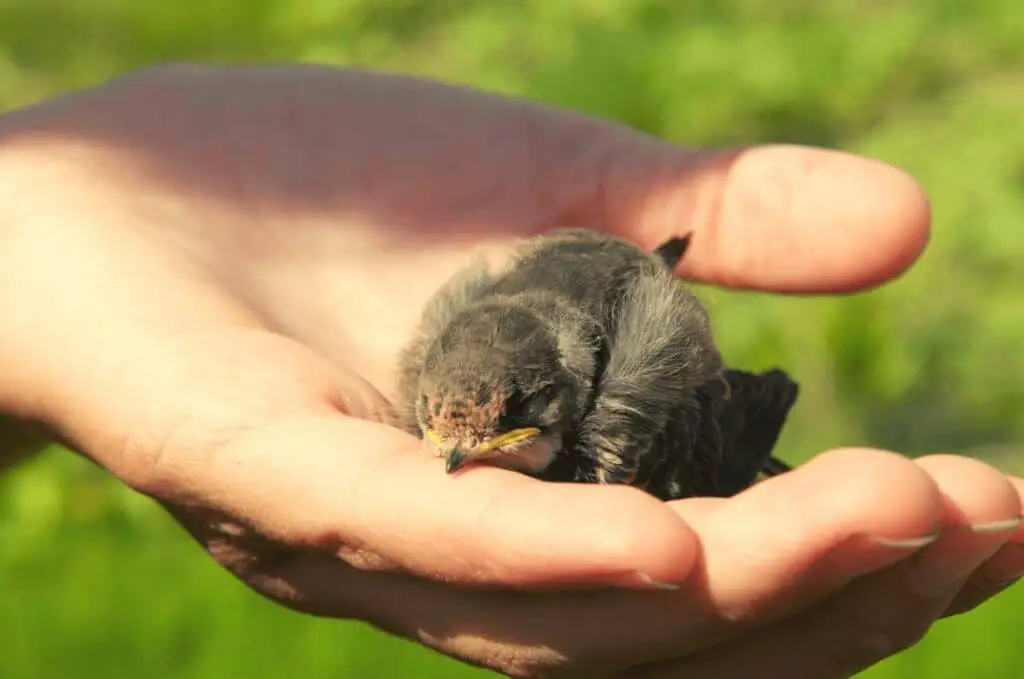Do you wonder what eagles really eat? Are you even afraid that one can pick up your cat or small dog? The diet of these birds can vary on the exact species but all of them are strict carnivores. In this article, you will learn everything important on eagles’ diet and I’m also giving a complete list of potential prey.

There are over 60 species of eagles that live all over the world except Antarctica. What they eat hugely depends on the habitat as well as the time of year. But I can say, you will be surprised by what these birds attack and go after. Don’t miss to watch the videos I show in the article! Let’s start with the most common types of eagles.
What Do Bald Eagles Eat?
Bald eagles are the only sea eagles of North America and they take most of their food out of the water. Many people think, that they live and hunt only around the coastlines of the continent, while in reality a big lake or river might be enough.
Their typical menu includes:
- Fish like salmons or trouts
- Frogs and other amphibia
- Mussels like oysters
- Crabs, lobsters and other seafood
- Despite their hard shell, turtles are often a preferred meal
As you see, there is not much that comes out of the oceans that eagles don’t eat. But they won’t feed on jellyfish most of the time.
Bald eagles are opportunistic foragers what means that they wouldn’t hunt small mammals like prairie dogs, squirrels and rabbits if they have the chance. They will also steal food from other birds that caught fish for example.
Even seafowls like seagulls and others are not safe from an attack if an eagle sees an opportunity.
That being said, bald eagles are not omnivores. They will reject every plant, fruit and seed.
The video below shows surprising eagle attacks. Different types go after various animals, even bears.
What Do Golden Eagles Eat?
The diet of the golden eagle is quite the opposite compared to bald eagles. While they are still carnivores that solely rely on meat, you won’t find them at the coastal lines feeding on fish and other seafood.
Their preferred prey are mammals of a decent size. Not too small not too big is the motto:
- Bats
- Bunnies
- Hedgehogs
- Rats
- Squirrels
But if food is scarce you might see a golden eagle going after much smaller or bigger animals as well. Especially if they find a potential prey which is very young or weak the result can be surprising:
- Mice
- Bears
- Bobcats
- Cheetahs
- Coyotes
- Deer
- Foxes
- Goats
- Jackals
- Jaguars
- Wolves
You see, even the offspring of other fearful predators is not safe, so aren’t ungulates.
Of course, reptiles like lizards and snakes as well as other birds can make a good meal. I’m going into detail on this further down the line.
What Do Harpy Eagles Eat?
Harpy eagles are giant predators that bring fear into the animal kingdom in the rainforest of South America. Nearly all animals are considered prey and no one is really safe. Harpy eagles will go after
- Possums
- Macaws
- Monkeys
- Sloths
Reptiles like iguanas and snakes (even small anacondas) can land on the plate of a harpy.
In the video below you can see how a harpy eagle hunts a monkey and feeds it to his young.
What Do Philippine Eagles Eat?
Another name for this bird of prey is monkey-eating eagle. I think it describes the diet very well and does not lead to wrong conclusions. This bird likes big prey!
Other animals that likely get eaten are:
- Bats
- Civets
- Flying lemurs
- Macaques
- Monitor lizards
- Snakes
Other birds of prey are not safe either.
What Do Wedge Tailed Eagles Eat?
The diet of the wedge-tailed eagle is similar to the one of golden eagles. Rabbits and other ground-dwelling animals are the lion’s share. So, 80 to 90 % of its diet is made of mammals, snakes and other reptiles.
Possums, small kangaroos, kookaburras, feral cats and wallabies are only some examples of preferred prey.
The main difference is, that tail-wedge eagles feed on carcasses more often. Whole flocks of this species can be seen around cadavers of larger animals all over Australia. Like other scavengers, they clean up roadkill and fulfill an important role in nature.
What Do Steppe Eagles Eat?
Steppe eagles are an outlier when it comes to their diet. While the main part is still meat, they are the only type of eagle that can be considered omnivores.
Like golden eagles, they like to feed on mammals and reptiles. Additionally, they share their appetite for carrion with wedge-tails. But no other member of their family is interested in insects.
Butterflies, grasshoppers and even snails and worms can make up half of their diet and more. Especially in winter when fresh meat is hard to find they don’t mind eating some carcass and maggots.
Do Eagles Eat Snakes?
Yes, all eagles eat snakes even venomous ones. But they have to be careful as they are not immune to snake venom.
The birds attack their victim so quickly that the snake has no chance to defend itself. When an eagle sees the snake it will swoop down and clutch the snake. During the flight, it will bite the head off of the snake to kill it.
Eagles don’t discriminate when it comes to snakes as food sources. All species are hunted. The only limit is the weight the bird can carry.
In the video below you can see how different types of eagles go after snakes.
Do Eagles Eat Birds?
Yes, eagles eat other birds and they do it quite often. As you can imagine, small to middle-sized birds that live in the natural habitat of eagles are preferred. You will often find pigeons, sparrows, starlings and crows on the menu.
However, eagles don’t refuse to eat other birds of prey like hawks and owls. But they will always choose the one that needs less effort first.
Eagles are especially dangerous to livestock that is kept in outside runs. Owners often protect their animals with a net from raptors. Chickens, ducks and geese get attacked what can lead to financial damage to producers.
Do Eagles Eat Foxes?
Yes, eagles eat foxes. But foxes are not the easiest to clutch so they are not necessarily the first choice.
Full-grown ones are agile and often too heavy. But young and baby foxes known as kits are never safe. They still have to learn a lot and are often unwary of the danger from above.
But when food is scarce during cold months even adult foxes can be attacked.
Do Eagles Eat Dead Animals?
Yes, eagles eat dead animals. For some species, carrion is just an occasional exception when food is scarce and nothing else available. Bald eagles and golden eagles for example prefer fresh meat over roadkill and carcasses.
Not at least these eating habits depend on the habitat. In the desert or savannah eagles are more likely to feed on dead bodies.
Types like the wedge-tail and the steppe eagle feed on dead animals more often. Sometimes 50 percent and more of their diet consist of carcasses. Together with vultures they can be considered scavengers which will only leave the bones.
The age of the birds also determines how often they will choose to eat dead animals. They always opt for a meal that takes minimal energy. Young birds develop and train their hunting skills within their first year. It might be, that these juveniles are less sophisticated when it comes to their diet.
Do Eagles Eat Cats and Dogs?
There are horror stories of pet owners who saw an eagle flying away with their cat or small dog. But are they true?
While most hope that the answer is no nothing could be further from reality. House cats are on the menu of eagles. Many cases are reported and nests with collars were found. In this article from usatoday.com, you can read more and even watch a video where a cat is fed to eagle nestlings.
And what about dogs? Of course, they are not an exception. While it’s unlikely that an eagle attacks large breeds, many cases where small dogs were carried away are reported.
Watch the video below where you can see unbelievable attacks that target cats and dogs.
Do Eagles Eat Squirrels?
Yes, squirrels are one of the favorite food of many eagle species. In every region where they naturally cross their ways, an eagle will always go after a squirrel.
Squirrels have a perfect size. They are agile but can’t defend themselves very well. When the opportunity is good, they can be an easy clutch.
In many cities in the northern states and Canada squirrels are more like a pest (although they can be very cute) and many people are glad when eagles swoop up with one of these little rodents.
Do Eagles Eat Raccoons?
Yes, raccoons are on the menu of eagles. To many people, the little animals are a nuisance so nobody is sad about another one that can’t burrow through the trash. However, raccoons are quite large but are perfect for adult eagles that are hungry.
What Eagles Don’t Eat
There is not much that eagles would refuse to eat, but every plant definitely belongs on this list. All species are strict carnivores. Grass? No way! Apples, berries and other fruits? No. Vegetables like tomatoes or cucumbers? Also no.
How Often Do Eagles Eat?
Eagles eat as much as they can. When the prey is big enough there might be some leftover. However, if an eagle is really full it doesn’t need to eat for a few days.
In many regions food won’t be available every day so that the birds often choose large prey over small ones like mice.
How Much Do Eagles Eat?
Adult individuals need to eat between 0.5 and 1 pound of food each day. But as I mentioned in the paragraph above an eagle doesn’t need to eat daily. They can store food in their crop. Appr. 2 pounds can fit in there what gives a lot of time for finding the next meal.
How Often Do Baby Eagles Eat?
Nestlings need food often no matter which species they belong to. With 8 times in a day eagle nestlings are quite patient. But the parents need to search for food constantly. After 10 to 12 weeks the young birds fledge out of the nest and start to hunt on their own.
How Do Eagles Hunt?
Eagles fly relatively low when they are on the hunt. When they notice a prey they strike it with their talons. After a short rush or pounce, it should be over.
If you see large birds circle in high attitude it’s likely that they are not eagles on the hunt.
The majestic birds of prey rely on the surprise effect. Longer fights after the bird clutched its prey are not rare but ongoing chases tend not to succeed.
The bodies of eagles are designed to hunt and kill. Mainly three features are responsible for the success of the birds:
- They have very strong eyesight and can see about 4 to 8 times better than humans. A rabbit in a distance of 2 miles can easily be observed by an eagle. Monocular and binocular vision enables them to use each eye independently from the other.
- Eagles have 4 talons with which they grab their prey. One of these talons is facing back and called “hallux”. With this structure holding an animal costs less effort, even with strong resistence. The power with that eagels can hold onto their prey is 10 times stronger than a human gripping something with his hand.
- Last but not least the bill of eagles is hooked. That makes it easier to tear flesh, skin and fur apart and replaces teeth to some extent.






